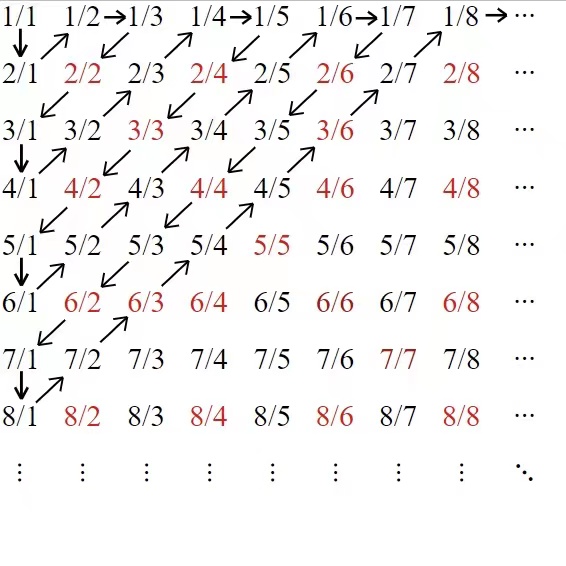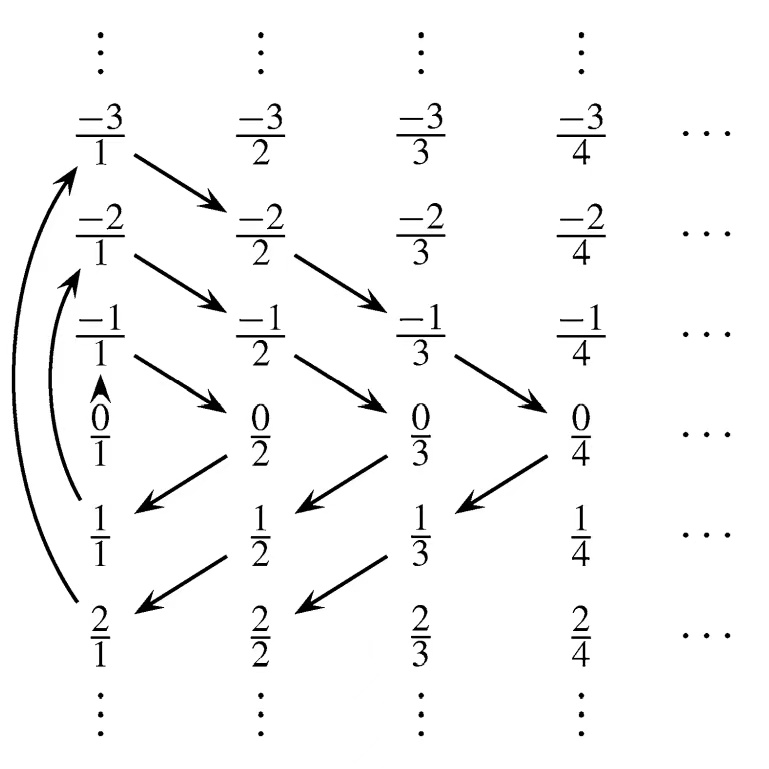测度论:Measure Theory (1)
这是我的笔记以及一些个人理解,其中大多证明系本人完成。
Notations
- \(\mathbb{N} = \left\{0, 1,2,\ldots\right\}\) - 自然数集
- \(\mathbb{Z} = \left\{\ldots,-2, -1,0,1,2,\ldots \right\}\) - 整数集
- \(\mathbb{Q} = \left\{ \frac{m}{n}: m, n \in \mathbb{Z}, n \neq 0\right\}\) - 有理数集
- \(\mathbb{R}\) - 实数集
- \(\mathbb{R}^{n} = \left\{ (x_{1}, x_{2}, \ldots, x_{n}): x_{i} \in \mathbb{R} \mbox{ for }1 \leq i \leq n\right\}\)
- Set membership: 若 \(x \in A\) ,则称 \(x\) 是集合 \(A\) 的一个元素(element)
- Set inclusion: \(\forall a \in A: a \in B \iff A \subset B\) ; \(A = B \iff A \subset B, B \subset A\)
- Intersection: \(A \cap B := \left\{x: x\in A \mbox{ and } x\in B \right\}\)
- Union: \(A \cup B := \left\{x: x \in A \mbox{ or } x \in B \right\}\)
- Difference: \(A \setminus B := \left\{x \in A: x \notin B\right\}\)
- Complement: \(A^{c} := \Omega \setminus A\) ,其中 \(\Omega\) 定义为全集
- Symmetric complement: \(A \Delta B := (A \setminus B) \cup (B \setminus A)\)
Russell's Paradox*
有的时候一个集合可以将自己作为元素,e.g. \(E = \ldots\left\{\left\{\left\{ 3 \right\}\right\}\right\} \ldots\),可以发现\(E \in E\)。
设集合 \(\mathcal{F}:= \left\{ X: \mathcal{F} \notin X \right\}\) 为所有不包含其自身作为元素的集合构成的集类,例如 \(\left\{1, 2, 4 \right\} \in \mathcal{F}\), \(\left\{a, b, c, d\right\} \in \mathcal{F}\), 但 \(E \notin \mathcal{F}\) 。那么 \(\mathcal{F}\) 是它自己的一个元素吗?
这种定义方式会产生悖论:假设 \(\mathcal{F} \in \mathcal{F}\),那么 \(\mathcal{F} \notin \mathcal{F}\) ;而假设 \(\mathcal{F} \notin \mathcal{F}\),则 \(\mathcal{F} \in \mathcal{F}\) 。这种集合的构造方式与集合论公理系统产生了矛盾,故如此构造的集合接下来将被排除在讨论范围之外。
假设我们有集合 \(A_{1}, A_{2}, A_{3}, \ldots\) ,考虑以下两个集合:
Countable intersections: \(X := \bigcap\limits^{\infty}_{n=1}A_{n} = A_{1} \cap A_{2} \cap A_{3} \cap \ldots\)
Countable unions: \(Y := \bigcup\limits^{\infty}_{n=1}A_{n} = A_{1} \cup A_{2} \cup A_{3} \cup \ldots\)
实际上,以上写法可以推广到更普遍的形式,对于collection of indices \(\Lambda\):
注意,上面两种写法分别为集合序列\(\left\{ A \right\}^{\infty}_{n=1}\)的可数交与可数并,也就是说为可数无穷的集合的交或并。而下面的两种写法中由于\(\Lambda\)不必为可数集,则\(\left\{ A_{\alpha}\right\}_{a\in\Lambda}\)也不必为可数,因此可以代表不可数无穷的集合的交或并。然而无论是可数还是不可数无穷,始终有:
为什么要强调这看似显而易见的这一点,当时在某个证明中,恰恰是这个简单的问题给初学者的我造成了一些困扰。例如一些看似能类比而实则不能的情况,例如以下这个例子:
Example 1.1
令\(\left\{A_{n}\right\}_{n\in\mathbb{N}}\) 为一个集合序列,such that:
那么自然数集是否属于这个序列的可数并呢?(i.e. \(\mathbb{N} \in \bigcup\limits_{n\in\mathbb{N}}A_{n}\) ?)
以下是当时我的困扰。
首先,很容易可以证明\(\mathbb{N} = \bigcup\limits_{n\in\mathbb{N}}\left\{0,1,...,n\right\}\):
\(\Longrightarrow\):对于任意的\(k \in \mathbb{N}\),有\(k \in \left\{0,1,...,k\right\} \subset \bigcup\limits_{n\in\mathbb{N}}\left\{0,1,...,n\right\}\),那么\(\mathbb{N} \subset \bigcup\limits_{n\in\mathbb{N}}\left\{0,1,...,n\right\}\)。
\(\Longleftarrow\):Conversely,可数并 \(\bigcup\limits_{n\in\mathbb{N}}\left\{0,1,...,n\right\}\)中的任意一项的元素都为自然数,那么可数并\(\bigcup\limits_{n\in\mathbb{N}}\left\{0,1,...,n\right\}\)的元素也都为自然数(若认为这个证明不够完美,可以用反证,即假设可数并中存在一个不为自然数的元素...),那么\(\bigcup\limits_{n\in\mathbb{N}}\left\{0,1,...,n\right\} \subset \mathbb{N}\)。
因此,如果我们能通过集合的可数无穷并与归纳(induction)的方法定义自然数集\(\mathbb{N}\),为什么不能用类似的方法证明以上的关系(i.e. \(\mathbb{N} \in \bigcup\limits_{n\in\mathbb{N}}A_{n}\))呢?
因为如果这个关系得以成立,那么存在\(n_{0} \in \mathbb{N}\),such that \(\mathbb{N} \in A_{n_{0}}\)。但是任意的\(A_{n}\)都是有限的,而\(\mathbb{N}\)是无限的。
De Morgan's Laws
Example 1.2
(The intersection of open sets can be a closed set.)
We have \(\bigcap\limits_{n\in\mathbb{N}}A_{n}=[0, 1]\).
Proof. (Example 1.2)
Firstly,for \(\forall x \in [0,1]\),since \(-\frac{1}{n} < 0 \leq x \leq 1 < 1+\frac{1}{n}\),then for \(\forall n \in \mathbb{N}\),we have \(x\in A_{n}\), hence \(x \in \bigcap\limits_{n\in\mathbb{N}}A_{n}\)。
Conversely,suppose \(\exists x \in \bigcap\limits_{n\in\mathbb{N}}A_{n}\),such that \(x \notin [0,1]\),i.e., \(x\in (-\infty, 0) \cup (1, \infty)\). W.l.o.g., suppose \(x \in (1, \infty)\), 则\(\exists \epsilon > 0\),such that \(x = 1 + \epsilon\)。However, for \(\forall \epsilon > 0\),let \(n = \lceil \frac{1}{\epsilon} \rceil + 1 \geq 1\),then we must have \(0 < \frac{1}{n} < \epsilon \implies 1 < 1 + \frac{1}{n} < 1 + \epsilon\)。This means for \(\forall x \in (1, \infty)\),there exists \(A_{n}=\left(-\frac{1}{n}, 1+\frac{1}{n}\right)\),such that \(x \notin A_{n} \implies x \notin \bigcap\limits_{n\in\mathbb{N}}A_{n}\), this produces contradiction. Similarly, there is contradicition when \(x \in (-\infty, 0)\). Therefore, \(\forall x \in \bigcap\limits_{n\in\mathbb{N}}A_{n}: x \in [0,1]\).
Definition. Cartisian product
The Cartisian product (笛卡尔积) \(A \times B\) of sets \(A\) and \(B\) is the set of all ordered pairs defined as:
Definition. Indicator function
The intercator function(指示函数) \(\mathbb{I}_{A}\) of set \(A\) is the function defined as:
Noted that \(\mathbb{I}_{A \cap B} = \mathbb{I}_{A} \cdot \mathbb{I}_{B}\), \(\mathbb{I}_{A \cup B} = \mathbb{I}_{A} + \mathbb{I}_{B} - \mathbb{I}_{A}\mathbb{I}_{B}\), \(\mathbb{I}_{A^{c}} = 1 - \mathbb{I}_{A}\).
Definition. Countability and Cardinality
Set \(A\) is called countable (可数的)or denumerable (可列的)if there is a one-to-one mapping between \(A\) and a subset of \(\mathbb{N}\).
Noted that it should be the "subset of \(\mathbb{N}\)" here, instead of \(\mathbb{N}\) itself. Otherwise, there is no one-to-one relationship between the set \(\left\{ 1, 2, 3\right\}\) and \(\mathbb{N}\) for instance, while the former is countable apparently.
Two sets \(A\) and \(B\) are said to have the same cardinality (基数,或势) if there is a one-to-one mapping between \(A\) and \(B\).
If there is no one-to-one correspondence between sets \(A\) and \(B\), then we say, the cardinality of \(B\) is bigger that of \(A\).
Example 1.3
由上述定义,我们可以称偶数和自然数“一样多”(等势)。
Assume the set of all even numbers to be \(A:= \left\{ 0, 2, 4, 6, \ldots\right\}\),then there is a one-to-one mapping:\(f: A \rightarrow \mathbb{N}, x \longmapsto \frac{1}{2}x\)。
Indeed, we can show the countability of the set of all rational numbers \(\mathbb{Q}\) intuitively by the following construction:
\(\frac{0}{1}, \frac{-1}{1}, \frac{0}{2}, \frac{1}{1}, \frac{-2}{1}, \frac{-1}{2}, \frac{0}{3} \frac{1}{2}, \frac{2}{1}, \frac{-3}{1}, \frac{-2}{2}, \frac{-1}{3}, \frac{0}{4}, \frac{1}{3}, \frac{2}{2}, \frac{3}{1}, \ldots\)
Notice the way we listed all rational numbers:
- Numerator:
- Denominator:
Or more intuitively,


Example 1.4 (Uncountability of \((0, 1]\))
Cantor证明了集合\((0, 1]\)不可列。我们可以将\((0, 1]\)上的实数以小数的形式写下来:
其中,\(a_{i, j} \in \left\{0, 1, \ldots, 8, 9\right\}\) for \(\forall i,j \in \mathbb{Z}^{+}\)。
假设它与\(\mathbb{N}\)之间存在一一映射关系。但是,我们总可以找到这么一个\(x \in (0, 1)\):
其中\(b_{k} \neq a_{k, k}\) for \(\forall k \in \mathbb{Z}^{+}, b_{k} \in \left\{0, 1, \ldots, 8, 9\right\}\)。
i.e., \(b_{1} \neq a_{1, 1}, b_{2} \neq a_{2, 2}, b_{3} \neq a_{3, 3}, \ldots\)
那么,如此构造的\(x \in (0, 1]\)不等于以上任何一个数\(x_{1}, x_{2}, \ldots\),也就是说,无论我们如何构造此一一映射,总能找到一个数\(x \in (0, 1]\)破坏该映射(使一一映射不成立),即\((0, 1]\) 与 \(\mathbb{N}\)之间不存在一一映射关系,所以\((0, 1]\)不可数。
Example 1.5
The cardinality of \((0, 1)\) is the same as the cardinality of \(\mathbb{R}\), since we can construct a mapping:
Theorem 1.1 (Cantor)
For an arbitrary set \(X\), there is no one-to-one correspondence between X and Y = 2^{X} (the power set of X).
Proof. (Theorem 1.1 Cantor)
Suppose there exists a one-to-one mapping \(\varphi: X \rightarrow Y = 2^{X}\), where \(Y\) is the power set of \(X\).
We know that \(\varphi\) is surjective by one-to-one mapping relationship. Then we have:
Since \(Y\) is the power set of \(X\), that is, \(Y\) contains all subsets of \(X\), then \(Z \subset X\). Now, we try to disprove the assumption of surjective relationship.
Define \(Z:= \left\{z \in X: z \notin \varphi(z) \right\}\), that is, for any element \(z \in Z \subset X\), \(z\) is not contained in \(\varphi(z)\). \(Z\) is a subset of \(X\), so \(Z \in Y\). Furthermore, by our surjective assumption: \(\exists z_{0} \in X: \varphi(z_{0}) = Z \in Y\). However,
-
If \(z_{0} \in Z\), according to the way we contructed \(Z\), we have \(z_{0} \notin \varphi(z_{0})\). We have \(\varphi(z_{0}) = Z\) above, then \(z_{0} \notin Z\), which shows contradiction.
-
If \(z_{0} \notin Z\), we must have \(z_{0} \in \varphi(z_{0})\). This is because if \(z_{0} \notin \varphi(z_{0})\), by the way how \(Z\) was constructed, we would otherwise have \(z_{0} \in Z\). Since \(\varphi(z_{0}) = Z\), there would be contradiction again.
We can conclude from the above that:
which contradicts to our assumption of surjection. Therefore, there exists no surjection from \(X\) to \(2^{X}\), and thus exists no one-to-one mapping \(X \rightarrow 2^{X}\).
Corollary 1.1
If \(Y\) is the power set of \(X\) (i.e. \(Y = 2^{X}\)), then the cardinality of \(Y\) is bigger than the cardinality of \(X\) (i.e. \(|Y| > |X|\)).
Proof. (Corollary 1.1)
We shown that there exists no one-to-one mapping between \(X\) and \(Y\) in Theorem 1.1 above. However, since \(Y\) is the power set of \(X\), then for \(\forall x \in X: \left\{x\right\} \in Y\), so that we can form a one-to-one mapping between \(X\) and \(A:= \left\{ \left\{ x\right\}: x\in X \right\} \subset Y\) (i.e. A is the set which contains all singletons of X). By definition, we conclude that \(|Y| > |X|\).
Definition. (\(\sigma-\)fields)
A family \(\mathcal{F}\) of subsets of a universal set \(\Omega\) is clled \(\sigma-\)field (or \(\sigma-\)algebra) if the following conditions hold:
- \(\Omega \in \mathcal{F}\)
- If \(A \in \mathcal{F}\), then \(A^{c} \in \mathcal{F}\).
(Closed under complement) - If \(A_{n} \in \mathcal{F}\) for all \(n = 1, 2, \ldots\), then \(\bigcup\limits^{\infty}_{n=1}A_{n} \in \mathcal{F}\).
(Closed under countable unions)
Definition.
Let \(A\) be an family of subsets of \(\Omega\), then there exists a unique smallest \(\sigma-\)field \(\mathcal{F}_{A}\) that contains every set in \(A\), which is called the \(\sigma-\)field generated by A.
Let \(\Omega = \mathbb{R}\), then the minimal \(\sigma-\)field containing all open intervals \((a, b)\) is called Borel \(\sigma-\)field, normally denoted by \(\mathcal{B} = \mathcal{B}(\mathbb{R}) = \mathcal{B}_{\mathbb{R}}\).
Notice a tricky example here. The word "contain" means "\(\in\)" mathematically. Therefore, for example, we should say the \(\sigma-\)field generated by \(\left\{ \left\{ 1 \right\} \right\}\) instead of \(\left\{1\right\}\).
Definition. (Fields)
A family \(\mathcal{A}\) of subsets of a universal set \(\Omega\) is called a field if the following conditions hold:
- \(\Omega \in \mathcal{A}\)
- \(\forall A, B \in \mathcal{A} : A \cup B\), \(A \setminus B \in \mathcal{A}\)
(Equivalently: \(\forall A, B \in \mathcal{A}: A \cup B \in \mathcal{A}\) and \(\forall A \in \mathcal{A}: A ^{c} \in \mathcal{A}\))
Proof. (Equivalent conditions of Fields)
\(\Longrightarrow\) Suppose \(\forall A, B \in \mathcal{A}: A \cup B\), \(A \setminus B \in \mathcal{A}\). Since \(\Omega \in \mathcal{A}\), then \(A^{c} = \Omega\setminus A \in \mathcal{A}\).
\(\Longleftarrow\) Suppose \(\forall A, B \in \mathcal{A}: A \cup B \in \mathcal{A}\), and \(\forall A \in \mathcal{A}: A^{c} \in \mathcal{A}\). For \(A, B \in \mathcal{A}\), we have \(A \setminus B = A \cap B^{c} = \left( A^{c} \cup B \right)^c\). By assumption, \(A \in \mathcal{A}\) indicates \(A^{c} \in \mathcal{A}\), so $\left( A^{c} \cup B \right) = \left( A^{c} \cup B \right)^c \in \mathcal{A} $, hence \(A \setminus B \in \mathcal{A}\).
Example 1.6
Let \(\Omega = \mathbb{R}\) and consider the family of subsets:
Proof that \(\mathcal{A}\) is a field but not a \(\sigma-\)field.
Proof. (Example 1.6)
First of all, \(\empty\) is empty, so that \(\empty^{c} = \Omega \in \mathcal{A}\).
Suppose for arbitrary non-empty sets \(A, B \subset \Omega\), where \(A, B \neq \Omega\) and \(A, B \in \mathcal{A}\), and one of \(A, A^{c}\) is finite, one of \(B, B^{c}\) is finite (cannot be finite simultaneously).
-
Suppose \(A, B\) are finite. Then \(A \cup B\) is finite \(\implies A \cup B \in \mathcal{A}\). Besides, \(A \setminus B = \left(A \cap B^{c}\right) \subset A\) is finite or empty \(\implies A \setminus B \in \mathcal{A}\).
-
Suppose \(A, B\) are infinite. Then \(A^{c}, B^{c}\) are finite, and so is \(A^{c} \cap B^{c}\). Then \(A^{c} \cap B^{c} \in \mathcal{A} \implies \left(A^{c} \cap B^{c}\right)^{c} = \left(A \cup B\right) \in \mathcal{A}\). Moreover, \(A \setminus B = \left(A \cap B^{c}\right) \subset B^{c}\) where \(B^{c}\) is finite, thus \(A \setminus B \in \mathcal{A}\).
-
W.l.o.g., suppose \(A\) is infinite, \(B\) is finite. Then \(A^{c}\) is finite, and so is \(A^{c} \cap B^{c}\). Hence \(A \cup B = \left( A^{c} \cap B^{c} \right)^{c} \in \mathcal{A}\). Furthermore, \(A^{c}\) and \(B\) are finite and so is \(A^{c} \cup B\). Therefore \(A \setminus B = \left(A^{c} \cup B\right)^{c} \in \mathcal{A}\).
Above all, \(\mathcal{A}\) is a field but not a \(\sigma-\)field necessarily, for instance let:
\(A_{1} = \left\{ a_{1} \right\}, A_{2} = \left\{ a_{2} \right\}, A_{3} = \left\{ a_{3} \right\}, \ldots , \in \mathcal{A}\)
then it is not necessary that: \(\bigcup\limits^{\infty}_{n=1}A_{n} \in \mathcal{A}\).
Theorem 1.2
The intersection of (any) family of \(\sigma-\)fields over the same universal set \(\Omega\) is a \(\sigma-\)field.
Proof. (Theorem 1.2)
- \(\Omega \in \mathcal{F}_{1}, \Omega \in \mathcal{F}_{2} \implies \Omega \in \mathcal{F}_{1} \cap \mathcal{F}_{2}\).
- for \(\forall A \in \mathcal{F}_{1} \cap \mathcal{F}_{2}\), we have \(A \in \mathcal{F}_{1}\) and \(A \in \mathcal{F}_{2}\), then \(A^{c} \in \mathcal{F}_{1}\) and \(A^{c} \in \mathcal{F}_{2}\), which implies \(A^{c} \in \mathcal{F}_{1} \cap \mathcal{F}_{2}\).
- for \(\forall A_{1}, A_{2}, \ldots \in \mathcal{F}_{1} \cap \mathcal{F}_{2}\), similarly, \(\bigcup\limits^{\infty}_{n=1}A_{n} \in \mathcal{F}_{1}\) and \(\bigcup\limits^{\infty}_{n=1}A_{n} \in \mathcal{F}_{2}\), hence \(\left( \bigcup\limits^{\infty}_{n=1}A_{n} \right) \in \mathcal{F}_{1} \cap \mathcal{F}_{2}\).
本文来自博客园,作者:车天健,转载请注明原文链接:https://www.cnblogs.com/chetianjian/articles/15942314.html



